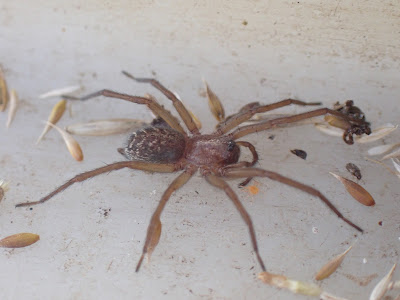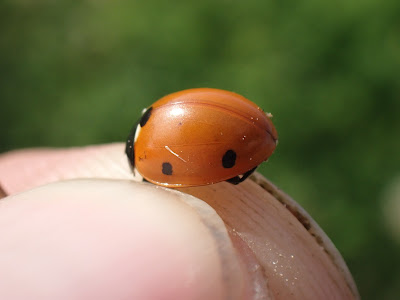I've just got back from a very exciting and spontaneous two-day stay on Anglesey. It involved what it best described as an avalanche of nudibranchs! It's all down to my friend Mark Colvin (and his daughter Charlotte). I had a weekend free for the first time in years and was planning to go to Cornwall. I was feeling rather discombobulated after having my first full blown migraine in 30 years on Friday morning, when Mark sent me a text saying he had just seen 23 nudibranchs of some eight to ten species! I got up the next morning, booked a B&B and was there by 4.00 pm for the next low tide.
Directly under the Anglesey side of the Menai Bridge is somewhat of a nudibranch hotspot. Indeed, I saw at least seven species when I was there. So, put on your breathing apparatus, set phasers to stun and prepare to be beamed down to the Planet of the Nudibranchs!
First up (and this is perhaps the commonest species there - albeit I have only seen this once before on Jersey) is the widespread Facelina auriculata! The iridescent blue/purple and long, gracile nature help to distinguish it from Facelina bostoniensis.
I am pretty sure this one was Facelina bostoniensis which was also present there in numbers. I have only seen this once before at the Pound.
I think this is also bostoniensis with eggs.
After the Facelina, Edmundsella pedata was the commonest, with more than 10 found under one rock grazing on hydroids (I will come back to this rock later). These are incredibly wonderful animals. Common on Jersey, I first saw this on the Isle of Wight but I have never seen it in Sussex.
Polycera quadrilineata (it's likely this and not norvegica based on the rhinophores and other factors but it's not easy to be 100% sure on this).
I found a mature Sea Lemon Doris pseudoargus. The others put it in a container with some of the other species, so you can see here how much bigger they are!


I found one Palio nothus under a rock too, I have only seen this on the Isle of Wight before but it seems a common and widespread nudibranch.
Yet amazing as this was, I was lacking a sea slug new to me! Dopamine deficiency was kicking in. So I went back for the low tide on Monday morning before I left Wales. The tide was coming in when I stumbled on the rock with all those grazing Edmundsella under. I thought I would count them using my close-focus binoculars when I spotted a totally different colour. There, poking out of the darkness of the hydroid forest, were a dozen bright orange-red, brilliantly white-tipped flares! There were also white highlights on the tentacles and rhinophores and not a suggestion of pink on the body. The rhinophores were also lealy not annulated like Facelina. This was a lifer! BUT it was under 4 mm and hard to get to.

I did eventually get it in a tray for a closer look and I soon came to the conclusion this was Microchlamylla gracilis (thanks to the amazing field guide). My 15th species of nudibranch in the British Isles! Nearly half of all the species I have ever seen I saw at this site in one weekend. Bonkers!



Sublime! We saw over 50 individual sea slugs on Saturday night, and they had at least two species on Friday night that I did not see (one of which I have never seen). I will therefore be back.
There was some other nice things there too. Like Lightbulb Sea Squirts (still scarce in Sussex).
Some Boring Sponge. It really is boring.
And lots of these hydroids, Entopleura larynx. . There are sea slugs that eat just this and it seems that the other saw one of these on Friday night! How exciting, I love to come away seeing lots of stuff but not everything as it leaves me wanting more! A massive thanks to Mark, Charlotte and all the others who came out!
Now I did a lot of other rock-pooling, snorkelling and entomology around the island in 48 hours but I will leave this for another time as it has been 15 years since I last visited the island and some 22 since I lived there, so I would like to do it justice. Now I'm off looking for rare mirids...
I am trying to finish my annual monitoring of the arable margins of the Norfolk Estate this weekend but the weather has been challenging. I shot up to Lee Farm for an hour yesterday afternoon at 3.30 pm after the storms dried out (to make this afternoon a more realistic possibility). This is year six of me monitoring the Peppering side (and year three of the Lee Farm side). This year has so far been exceptional and it is amazing just how any new species are still turning up.

So, here is what happened in just one hour of monitoring two arable margins of two fields yesterday. I recorded 103 field dets in that hour, not in itself exceptional. At about 26 minutes into the survey I looked in the net and saw this!!! Carpocoris purpureiepennis. A recent colonist and a lifer, with very few UK records so far. It was the first to be noted on the new pan-species listing website. I was pretty stoked with this, as there are very few shieldbugs in the UK I have not seen now. I carried on looking through the same sweep net sample, and saw this! The same species but showing how variable they are.
Here they are side by side.
They are pretty big bugs, and strikingly different to anything else. They also look pretty odd underneath.
I walked back and swept a third one, which was very soft and clearly teneral, showing confirmed breeding. Apart from a nymph of this genus recorded in Kent earlier this month, this seems to be the first confirmed breeding of this species in the UK according to Tristan Bantock. Now there are lots of other species in the genus on the Continent, so you really do need to check any Carpocoris carefully.
On the same margin, I turned one big flint and found Eratigena picta, a Nationally Rare house spider with very few records nationally. I had in this field last year and last month.
Other species seen in that hour included a nymph of a Vernal Shieldbug, Dark Green Fritillary, Sitochroa palealis and Cerceris quinquefasciata. It was an eventful hour. I particularly enjoyed this five-spotted ladybird, which is clear an aberrant Seven-spot Ladybird, but shows the importance of correctly writing common names.
But the other day at Peppering was also really exciting. The first margin had a Hornet Robberfly! The first one I have recorded up there in six years.Small Blues have colonised the margins this year with the new seed mix providing plenty of Kidney-vetch.
I found this scarce migrant moth, Loxostege sticicalis. A lifer and with less than 30 Sussex records. Sitochroa palealis and Evergestis extimalis were also new to the site. There were plenty of Clouded Yellows too.Then I nearly tripped over this huge Large Conehead, another recent colonist! This is my first for the site and my first West Sussex record. This is an impressive cricket.
I also heard a Whimbrel flying over and found Knapweed Broomrape.
Last month was exciting too! I stumbled on my first ever Small Marbled there.
As well as a couple of Bordered Straws! Who needs a moth trap when you can just stumble upon moths in fields like this?! It also shows just how much insect migration is happening this year (although I have recorded many more migrant insects here than anywhere else on the Downs this year).
These arable margins are all in place to help the Grey Partridge project up there, which is a fantastic initiative and is really working to help biodiversity across the board. The farmers and keepers are working together with ecologists to produce something really exceptional. I have recorded over 1,000 species on just 16 fields over the years (and have hardly mentioned here the host of native rare species, with over a 100 noted so far). This year, the margins have been incredibly exciting and diverse though. Now hopefully I can get up there this avo and finish the survey for the year...










































